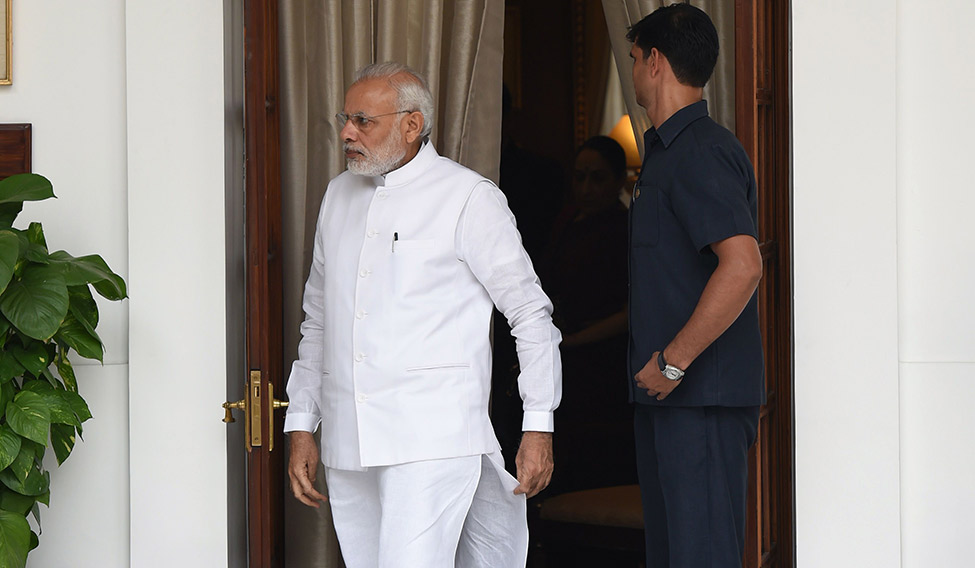As 2016 hurtled to a close, Prime Minister Narendra Modi brought in a disruptor—an idea that shocked people out of their senses and captured their imagination. Modi, in fact, dropped a bombshell even as the focus was turning towards the assembly elections to be held in early 2017. In a surprise address to the nation on November 8, he announced the decision to demonetise Rs 500 and Rs 1,000 notes with immediate effect, jolting everyone, including his political rivals.
The stated motive behind the decision was to bring to an end the parallel economy that runs on cash and evades the tax net. However, it has political implications, coming as it did just a few months before assembly elections were to be held in five states—Uttar Pradesh, Punjab, Uttarakhand, Goa and Manipur. Modi has set the tone for politics in the coming months, and it is believed that the effects of it would be seen in the Lok Sabha elections of 2019, too.
The euphoria over the surgical strikes on terrorist camps across the Line of Control was dying down and the government was cornered by opposition parties over increased hostilities at the border with Pakistan, continuous terrorist attacks and implementation of One Rank, One Pension for retired servicemen. Modi was also being attacked by his political opponents for being ‘anti-poor’ and caring only for the rich, a narrative that had begun with the expensive monogrammed suit that he wore when he hosted US President Barack Obama in January 2015. They had also been reminding him about his election promise of bringing back black money stashed abroad and putting Rs 15 lakh into the account of each Indian from the money recovered.
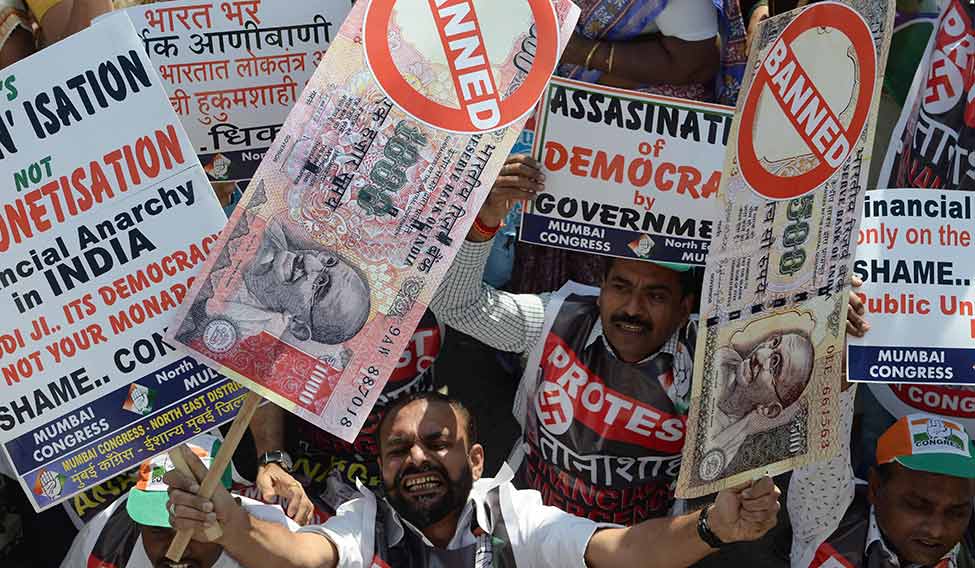 Money, money, money: People take to the streets in Mumbai, protesting the government’s demonetisation drive | AFP
Money, money, money: People take to the streets in Mumbai, protesting the government’s demonetisation drive | AFP
As brand Modi looked increasingly frayed and the development card—which was extremely successful in the 2014 Lok Sabha elections—was not working as a vote catcher any longer, a game changer of an idea was needed urgently as the BJP went into the assembly elections. Modi and his party hoped that demonetisation would prove to be exactly that.
So far, judging by the strong reactions of Modi’s political rivals, it has proved to be a huge disruptor. It has set the stage for the assembly polls, and rivals, especially in the politically crucial state of UP, have reacted furiously.
Chief Minister Akhilesh Yadav and Bahujan Samaj Party supremo Mayawati, who hopes to come back to power, were prompt in saying that the main target of the move was the state elections.
Mayawati has been at the centre of conjecture regarding what has happened to her party’s cash donations—after all, her mentor, BSP founder Kanshi Ram, had started the party with the slogan ‘one note, one vote’ as he sought crowd funding for the party. For this, Mayawati had been accused of unabashedly asking for cash from her supporters and even taking money for tickets.
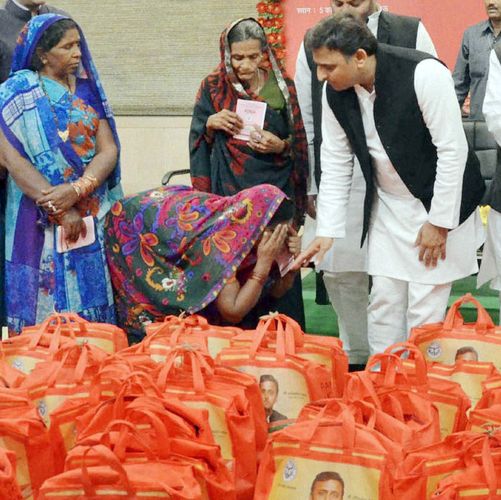 Bags of hope: Akhilesh Yadav distributing food during the launch of National Food Security Act in Lucknow. The Samajwadi Party is battling anti-incumbency and internal fights | PTI
Bags of hope: Akhilesh Yadav distributing food during the launch of National Food Security Act in Lucknow. The Samajwadi Party is battling anti-incumbency and internal fights | PTI
The BJP is intent upon exploiting the demonetisation drive electorally. The assessment is that while the party may have alienated the trading class with the move, it has projected Modi as someone who will ensure that the rich are made to pay for stashing black money, and the poor benefit from it. Much in tune with this idea, Modi indulged in hard sell of the move as he addressed a public rally in Moradabad in the poll-bound UP. Referring to the queues outside banks, he said they were meant to “end all queues.” He even told the crowd that he was finding ways to ensure that the poor, whose Jan Dhan accounts have been used to deposit unaccounted wealth, end up benefiting from it.
If it works in the assembly elections, it will further boost brand Modi. But he has not just the state elections in mind. The image consolidation exercise is aimed at the Lok Sabha elections in 2019 as well. Modi would be hoping to enhance his stature as an anti-corruption, anti-black money crusader, who is also somewhat of a modern-day Robin Hood as he takes away unaccounted wealth from the rich, so that the poor benefit from it.
This is precisely the reason Modi’s rivals like Mamata Banerjee, Arvind Kejriwal, Rahul Gandhi and Nitish Kumar have reacted the way they have. Mamata has vowed to remove Modi from Indian politics, and is perhaps the only political leader to have demanded a roll back of demonetisation. Kejriwal, regardless of his anti-corruption antecedents dating back to the movement headed by Anna Hazare, has been highly critical of the move, calling it a big scam. Rahul has focused more on the impact of the drive on the lives of the people, the difficulties that they are facing and the effects of it on the economy.
Nitish, in a way, has broken the ranks of the opposition to support demonetisation. A staunch rival of Modi, he has, nevertheless, backed the move having sensed that while the public has been inconvenienced, it is not angry. On the contrary, the public would support a move which it feels is aimed at acting against the unscrupulously rich. Nitish, who fancies his chances as a prime ministerial probable in the 2019 elections, would want to enhance his image as a leader who is not hesitant to support tough measures in favour of the larger good, much in line with his decision to prohibit alcohol in Bihar.
However, it remains to be seen if the voter really sees virtue in demonetisation or, distressed by the cash crunch, actually turns against the BJP.
UP could still turn out to be an alternation of the Samajwadi Party and the BSP, as has been the case in the last few elections, with local issues and caste and community calculations coming into play. The BJP is beset with problems of its own, although Amit Shah is investing heavily in the state and has set a target of winning 265+ seats or two-thirds majority. The BJP won 71 out of total 80 seats in the state in the 2014 Lok Sabha polls.
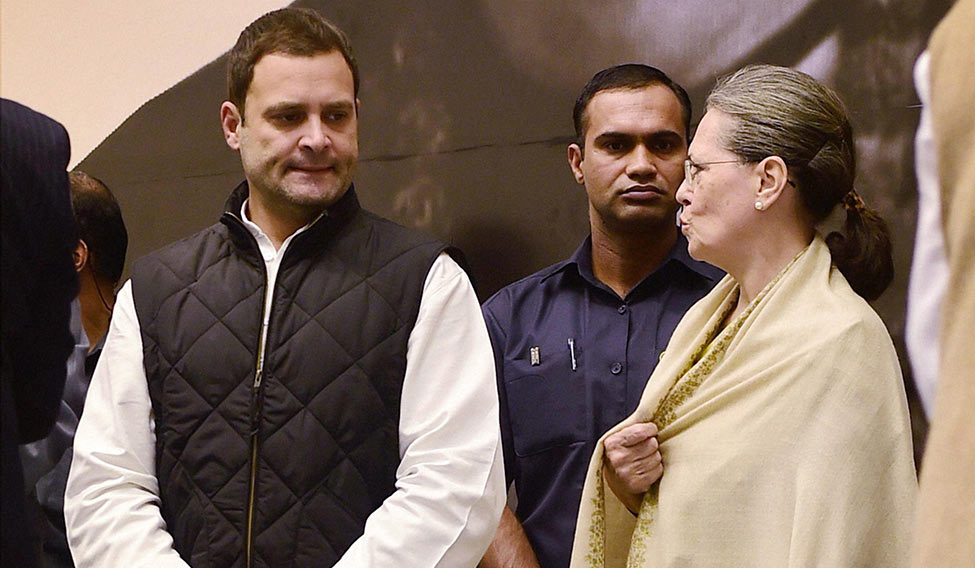 Stepping up: Rahul Gandhi is expected to become party president, a position held earlier by his grandmother, father and mother | PTI
Stepping up: Rahul Gandhi is expected to become party president, a position held earlier by his grandmother, father and mother | PTI
However, the Modi wave, which helped the party mop up those many seats then, has ebbed. There is no emotive issue like Ram Mandir in play. The party does not have a chief ministerial face to project, which could prove to be a big handicap. Its caste calculus is more or less the same as in the general elections, relying on a combination of Other Backward Castes. But its attempts to woo dalits have been thwarted by an increase in atrocities against the community and the strengthening of the perception that the BJP is inherently anti-dalit.
The other parties also enter the race with their own set of problems. The SP is besieged with intense rivalries within the Yadav family, with battle lines drawn between Akhilesh and uncle Shivpal Yadav. Akhilesh, who has tried to build for himself an image of a ‘pro-development, progressive leader’, did emerge as the face of the party for the polls when calm returned. But, the feud has given rise to doubts about how cohesive a force the party would be in the electoral battle. A major concern was that the family strife could force a split of votes, and Muslims, a loyal votebank, could think of other options. It was perhaps this concern that made the SP try and forge an alliance of ‘like-minded, secular forces’, much on the lines of the Mahagathbandhan in Bihar, but it did not succeed in doing so.
Mayawati, theoretically, has the best chance. UP has alternated between the SP and the BSP in the last few elections. The SP is battling anti-incumbency and is dealing with an internal fight. Muslims, a core vote bank of the SP, are said to be upset with the party on account of unkept promises, such as reservation for the community, and incidents of communal violence. But Mayawati is weakenend by a series of desertions from the party, which include some senior leaders. She would hope to win the backing of the Muslim community, and is working hard to form a Muslim-dalit alliance. Dalits, who form 21 per cent of the population of the state, support her. Muslims account for 18 per cent of the population. She has campaigned in Muslim-dominated areas such as Saharanpur and Azamgarh. However, the Muslims would be wary of supporting her, given her past record of having shared power with the BJP.
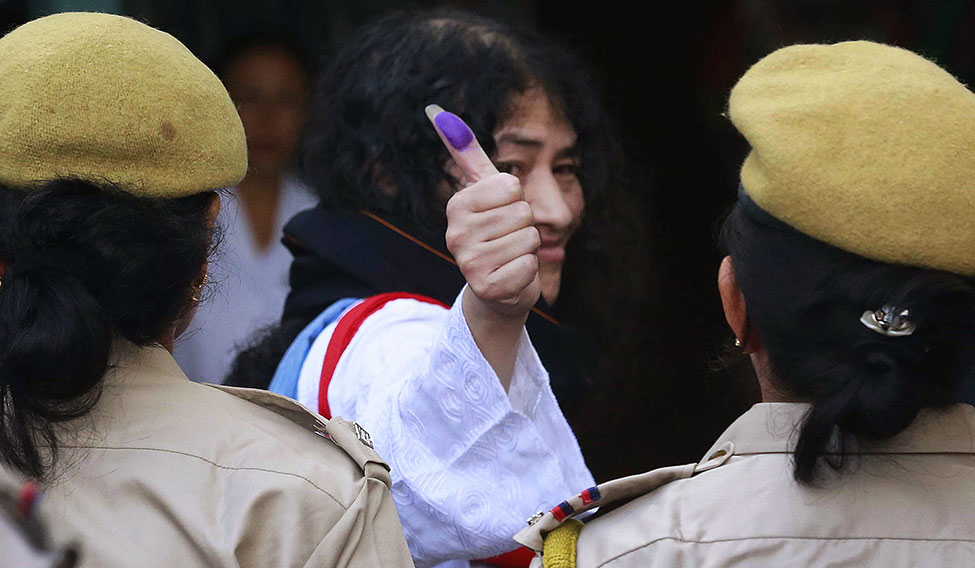 In the fray: Political activist Irom Sharmila after ending her 16-year hunger strike. Having launched her political party, she will field 20 candidates in the upcoming polls | AP
In the fray: Political activist Irom Sharmila after ending her 16-year hunger strike. Having launched her political party, she will field 20 candidates in the upcoming polls | AP
The Congress continues to look like an also-ran, despite a hectic, high-voltage campaign crafted by strategist Prashant Kishor. The party’s aim is to get enough seats to find some role in government formation. It did get media space, with the Kishor-designed strategy of having Rahul travel across the state as part of a ‘Kisan Sandesh yatra’ and hold ‘Khat Sabhas’ en route. The buzz around Priyanka Vadra campaigning extensively also generated some interest. However, as the election draws nearer, it is becoming increasingly clear that the inherent weaknesses of the party in the state, such as lack of organisation and dearth of local talent, are proving to be too much to surmount. It is learnt that Priyanka’s decision not to campaign in a big way in UP was dictated by the party’s pessimistic outlook, as it was felt that she need not be wasted for what is not even half-a-chance. There is also pent up anger among the Congress leaders with regard to Kishor’s style of functioning. They feel that he has overstepped his mandate—which is to strategise the campaign and take care of logistics—by getting into what are purely internal party matters, such as selection of candidates. His meetings with the Samajwadi Party leaders and others, purportedly to explore chances of forging an alliance, did not go down well with Congress leaders. The party’s latest outreach programme in UP, this time to appeal to the dalit voter, has no involvement of Kishor and his team.
While the focus is on UP, the election that could have long-term ramifications could well be the one to choose the next government in Punjab. It is an election that will determine the future of Kejriwal and his Aam Aadmi Party. The AAP was first off the blocks in launching an election campaign in Punjab. It is proving to be a formidable challenge to the Congress, which otherwise had a strong chance to replace the Akali government that is burdened with an anti-incumbency of two terms. If the AAP wins Punjab, it will help in hastening the rise of the party as a national force, and the elevation of Kejriwal as the main rival of Modi. However, if it loses, it will put the brakes on the AAP’s progress as it attempts to increase its national footprint, and even raise existential questions for the party.
The AAP has also set its sights on Goa, where the BJP is in power. Kejriwal sees a Delhi-like situation in Goa, where he feels that the people could be looking for a third alternative. The AAP, he feels, could provide them with that option.
The BJP has made its intent of expanding its footprint in the northeast clear. Afer winning Assam and effecting a change of government in Arunachal Pradesh, the party has set its sights on Manipur. Himanta Biswa Sarma, who left the Congress to join the BJP prior to assembly elections in Assam, is now the BJP’s point man in the region, and has been given the task of preparing the party’s strategy for Manipur. The party hopes to emerge as an alternative to the Congress, which is in power in the state. It hopes to get the backing of the Vaishnavite Meitis of the state. The BJP has made electoral advancements, winning an assembly by-poll in Manipur for the first time and even winning ten out of 27 seats in Imphal municipal council this year, as against just one in 2011.
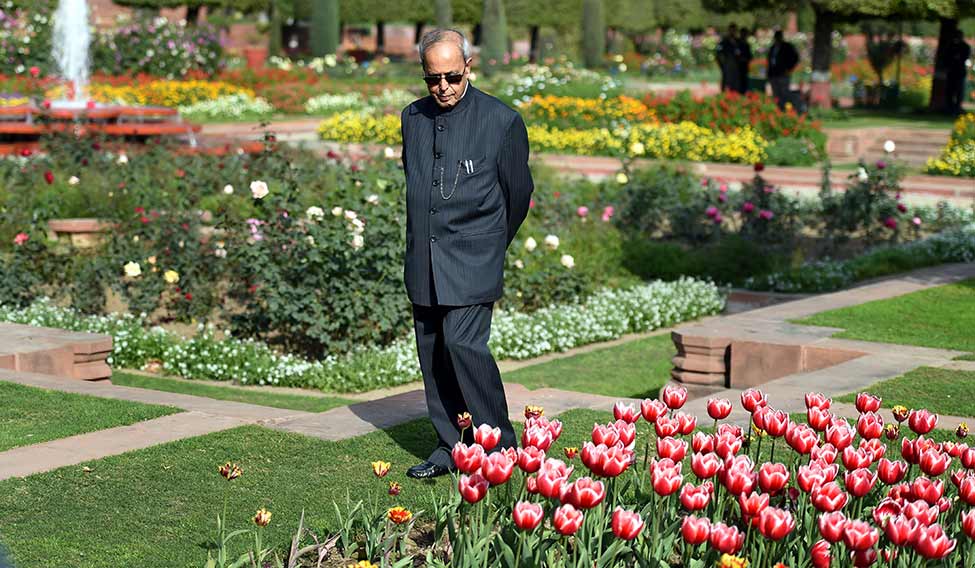 Time to go? Pranab Mukherjee may not be renominated as president. The BJP would want someone who identifies with its ideology in the Rashtrapati Bhavan | Aayush Goel
Time to go? Pranab Mukherjee may not be renominated as president. The BJP would want someone who identifies with its ideology in the Rashtrapati Bhavan | Aayush Goel
Elections in Manipur will also see the political debut of activist-turned-politician Irom Sharmila. She has launched her campaign, and her party, People’s Resurgence and Justice Alliance, will field 20 candidates in the polls. It remains to be seen how Manipuris, who did not take very kindly to her decision to give up her fast, will respond to her call for votes.
The hill state of Uttarakhand saw plenty of political action in 2016, with the BJP’s efforts to topple the Harish Rawat regime by enlisting the support of his dissidents, and the Supreme Court ruling in favour of the Congress government. Rawat had earned the sympathy of people as he was seen as a victim of a ‘power-hungry’ Central government. However, the sympathy has dissipated and he is battling charges of being authoritarian in his style of functioning. In this situation, the BJP stands to gain on the dint of surgical strikes and the demonetistion drive. However, it finds itself in an unenviable position of not being able to project a chief ministerial face despite having four former chief ministers in its ranks.
Yet another crucial election will take place in 2017—that to choose the next president of India. It is widely believed that Pranab Mukherjee may not be renominated and that the BJP would want to install a person belonging to its own ideological bandwidth in the Rashtrapati Bhavan. The party knows that it has the best ever chance to have a ‘saffron’ president, with 282 MPs in the Lok Sabha and 1,126 MLAs across the country. The number of MLAs could go up further if the BJP improves its seats tally in the assembly polls.
The Congress party is in for a generational change, with party vice president Rahul Gandhi likely to be named party president soon. The Congress Working Committee has requested party chief Sonia Gandhi, who is not in the best of health, to do what is required. This frees Rahul’s elevation from the results of the assembly elections. However, Rahul, who made his political debut in the 2004 Lok Sabha elections and was appointed vice president of the party in 2013, faces the challenge of winning the confidence of Congress workers and leaders as he puts in motion a plan to revive the party. He has to fill very big shoes, which were in the past occupied by his grandmother Indira Gandhi and father Rajiv Gandhi. Sonia, too, overcame initial hurdles posed by her foreign origin to be highly respected in Indian politics. The challenges before Rahul include arresting the free-fall that the Congress finds itself in, shrunk to just 44 MPs in the Lok Sabha and reduced to power in just five states, with Karnataka being the only big state where it rules.
If a new leader rises in the Congress, there is an end of an era in Tamil Nadu. The death of J. Jayalalithaa raises questions about the future of her party, the AIADMK. In a state where politics is ruled by celebrities, and leaders have cult-like following, the AIADMK was largely identified by Jayalalithaa. The party runs the risk of disintegrating in the absence of the leader, and the DMK is expected to try and get the ruling party’s MLAs to break ranks. The coming months will tell if the different factions in the AIADMK will stick together to make the most of the people’s mandate to run the state for five years. There is now a vacuum in Tamil Nadu politics, which national players like the BJP and the Congress would attempt to fill. However, these parties lack organisation as well as tall leaders in the state.
The coming months promise to be politically quite eventful.




